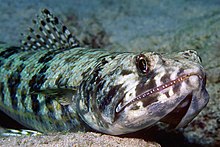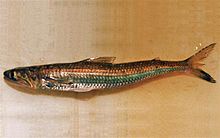Lizardfish
| Lizardfish | ||||||||||||
|---|---|---|---|---|---|---|---|---|---|---|---|---|

|
||||||||||||
| Systematics | ||||||||||||
|
||||||||||||
| Scientific name | ||||||||||||
| Synodontidae | ||||||||||||
| Gill , 1862 |
The lizardfish (Synodontidae) are a family of bottom-dwelling small predatory fish. The majority of the species live on sandy bottoms in flat, tropical regions of all three oceans, some also in brackish water .
Appearance
Lizardfish are slender, elongated in shape. They have no fin spines and are 12 to 50 centimeters long. The predators have a deeply split mouth with many fine, very sharp teeth also on the tongue. The number of Branchiostegal rays is 8 to 26, those of the vertebrae 39 to 67. The supramaxillary, a bone of the upper jaw, is small. The lizardfish from deeper ocean areas are often bright red in color, fish from the shallow water are sand-colored for camouflage, often with a pattern that dissolves their shape.
nutrition
Lizardfish lie in wait , or buried in the sandy bottom or between coral breaks for their prey, which can consist of small fish such as damselfish , gobies , wrasse but also shrimp or squid . They snap for prey up to their own size.
Multiplication
Not much is known about the reproduction of the lizardfish. In contrast to many other lizardfish relatives , they are not hermaphrodites , but of separate sexes. They spawn in open water. The transparent larvae that hatch after two to three days are extremely elongated. At first they live in planktonic form and, when they reach a size of 3 to 3.5 centimeters, they take on the bottom life of the adults.
Internal system
There are two subfamilies, five genera and over 70 species :
Subfamily Synodontinae
In the species of the Synodontinae subfamily, the pelvic fins are supported by eight fin rays. The dorsal fin has 10 to 15 rays, the anal fin 8 to 16 rays. An adipose fin is usually present. The scales along the sideline are not enlarged. The maximum length is 60 cm.
- Genus Synodus
- Synodus amaranthus Waples & Randall, 1988
- Synodus binotatus Schultz, 1953
- Synodus capricornis Cressey & Randall, 1978
- Synodus dermatogenys Fowler, 1912
- Synodus doaki Russell & Cressey, 1979
- Synodus Englemani Schultz, 1953
- Synodus evermanni Jordan & Bollman, 1890
- Synodus falcatus Waples & Randall, 1988
- Synodus foetens (Linnaeus, 1766)
- Synodus fuscus Tanaka, 1917
- Synodus Gibbsi Cressey, 1981
- Synodus hoshinonis Tanaka, 1917
- Indian lizardfish ( Synodus indicus ) (Day, 1873)
- Synodus intermedius (Spix & Agassiz, 1829)
- Tail- spot lizardfish ( Synodus jaculum ) Russell & Cressey, 1979
- Synodus janus Waples & Randall, 1988
- Synodus kaianus (Günther, 1880)
- Synodus lacertinus Gilbert, 1890
- Synodus lobeli Waples & Randall, 1988
- Synodus lucioceps (Ayres, 1855)
- Synodus macrocephalus Cressey, 1981
- Synodus macrops Tanaka, 1917
- Synodus macrostigmus Frable, Luther & Baldwin, 2013
- Synodus marchenae Hildebrand, 1946
- Synodus nigrotaeniatus Allen et al., 2017
- Synodus oculeus Cressey, 1981
- Synodus pacificus Ho et al., 2016
- Synodus poeyi Jordan, 1887
- Synodus randalli Cressey, 1981
- Red-marbled lizardfish ( Synodus rubromarmoratus ) Russell & Cressey, 1979
- Synodus legendary Waite, 1905
- Synodus saurus (Linnaeus, 1758)
- Synodus scituliceps Jordan & Gilbert, 1882
- Synodus Sechurae Hildebrand, 1946
- Synodus similis McCulloch, 1921
- Synodus synodus (Linnaeus, 1758)
- Synodus tectus Cressey, 1981
- Synodus ulae Schultz, 1953
- Synodus usitatus Cressey, 1981
- Synodus variegatus (Lacepède, 1803)
- Genus Trachinocephalus
- Trachinocephalus atrisignis Prokofiev, 2019
- Trachinocephalus gauguini Polanco et al., 2016
- Trachinocephalus myops (Forster, 1801)
- Trachinocephalus trachinus Temminck & Schlegel, 1846
Subfamily Harpadontinae
The species of the subfamily Harpadontinae occur only in the Indo-Pacific . Their heads are less pointed than in the subfamily Synodontinae and they have more teeth. Your pelvic fins are supported by nine fin rays. The dorsal and anal fins have 9 to 15 fin rays. In the secondary pelagic genus Harpadon , which also migrates in brackish water regions, the head and body, with the exception of part of the rear body and the scales along the sidelines, are scaly. Harpadon has one, Saurida two supramaxillaries.
- Genus Harpadon
- Harpadon erythraeus Klausewitz, 1983
- Harpadon microchir Günther, 1878
- Harpadon nehereus (Hamilton, 1822)
- Harpadon nudus Ganga & Thomas, 2015
- Harpadon squamosus (Alcock, 1891)
- Harpadon translucens Saville-Kent, 1889
- Genus Saurida
- Saurida argentea Macleay, 1881
- Saurida brasiliensis Norman, 1935
- Saurida caribbaea Breder, 1927
- Saurida elongata (Temminck & Schlegel, 1846)
- Saurida filamentosa Ogilby, 1910
- Hawaiian Lizardfish ( Saurida flamma ) Waples, 1982
- Graciler lizardfish ( Saurida gracilis ) (Quoy & Gaimard, 1824)
- Saurida grandisquamis Günther, 1864
- Saurida isarankurai Shindo & Yamada, 1972
- Saurida lessepsianus Russell et al., 2015
- Saurida longimanus Norman, 1939
- Saurida microlepis Wu & Wang, 1931
- Saurida micropectoralis Shindo & Yamada, 1972
- Saurida nebulosa Valenciennes, 1850
- Saurida normani Longley, 1935
- Saurida pseudotumbil Dutt & Sagar, 1981
- Saurida suspicio Breder, 1927
- Saurida tumbil (Bloch, 1795)
- Saurida tweddlei Russell, 2015
- Saurida umeyoshii Inoue & Nakabo, 2006.
- Brush-toothed lizardfish ( Saurida undosquamis ) (Richardson, 1848)
- Saurida wanieso Shindo & Yamada, 1972
literature
- Baensch / Patzner: Mergus Sea Water Atlas Volume 6 , Mergus-Verlag, Melle, ISBN 3-88244-116-X
- Joseph S. Nelson : Fishes of the World . John Wiley & Sons, 2006, ISBN 0-471-25031-7
- Kurt Fiedler: Textbook of Special Zoology, Volume II, Part 2: Fish . Gustav Fischer Verlag Jena, 1991, ISBN 3-334-00339-6
Web links
- Lizardfish on Fishbase.org (English)
- Pictures of different species of lizardfish from the Indo-Pacific (Ger.)









